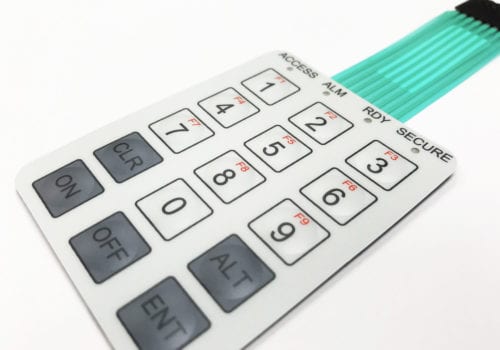Recognizing Membrane Switches: The Trick to Sturdy and Dependable Controls
Membrane layer changes represent a crucial facet of modern interface style, mixing functionality with durability in numerous applications. As we check out the ins and outs of membrane layer switches, it becomes clear that their function in boosting control systems is both profound and intricate, elevating questions regarding how ideal to leverage their capacities in future technologies.
What Are Membrane Switches?
Membrane layer buttons are an innovative solution in the world of user interface innovation, integrating capability and layout perfectly. These tools serve as a user interface in between customers and digital systems, integrating numerous parts right into a small format. Normally constructed from adaptable, slim layers of products, membrane layer buttons are made to reply to touch, allowing individuals to connect with equipment and electronic devices successfully.
The main aspects of a membrane button consist of a printed circuit layer, graphic overlay, and a spacer layer that prevents unintended activation. The visuals overlay can be personalized to show brand identification or individual choices, boosting aesthetics while making certain use. Membrane switches are commonly utilized in numerous applications, including clinical gadgets, customer electronic devices, and industrial tools, owing to their longevity and resistance to ecological aspects such as dampness and dirt.
One of the crucial benefits of membrane buttons is their capacity to hold up against wear and tear, making them suitable for high-traffic settings. In addition, they are light-weight and need minimal space, permitting ingenious layouts in item advancement. On the whole, membrane layer changes represent a reliable and functional option for modern electronic interfaces, weding technology with user-centric style concepts.

How Membrane Layer Changes Job
The operation of membrane layer changes joints on a straightforward yet reliable system that converts customer input into electronic signals. When an individual presses the button, the top layer flaws, permitting a conductive aspect in the circuit layer to make contact with an equivalent conductive pad on the bottom of the graphic overlay.
The layout of membrane switches can differ, but they usually include domes or tactile components to give responses to the user, improving the overall experience. The materials utilized in membrane layer buttons, such as polyester or polycarbonate, add to their durability and resistance to environmental aspects, including wetness and dust. The printed circuits are typically encapsulated, which shields them from wear and tear over time.

Advantages of Membrane Layer Buttons
One of the main benefits of membrane buttons is their flexibility in layout, enabling them to be tailored to satisfy details customer requirements and visual like this requirements. This adaptability reaches various industries, where different forms, sizes, and colors can be employed to improve user interaction and visual appeal.
Furthermore, membrane layer buttons are understood for their sturdiness. Created from robust products, they are resistant to dirt, dampness, and physical wear, which considerably expands their lifespan compared to traditional mechanical buttons. This sturdiness makes them specifically suitable for high-traffic atmospheres and applications needing long life.

In addition, membrane switches provide a structured account, resulting in a thinner design that can be incorporated into various devices without including mass. This feature not only enhances the visual appeal yet additionally adds to a much more ergonomic item design.

Applications of Membrane Layer Buttons
Flexible and straightforward, membrane layer buttons find applications across a broad variety of markets, consisting of medical tools, consumer electronics, and industrial devices. In the medical area, these switches are indispensable to tools such as diagnostic tools, person tracking systems, and infusion pumps, where dependability and ease of cleaning are vital. Their ability to maintain and hold up against harsh atmospheres performance makes them perfect for such applications.
In consumer electronic devices, membrane buttons are utilized in products see it here like microwaves, cleaning makers, and push-button controls - membrane switch. Their smooth layout enables for instinctive interface, enhancing the total user experience while providing resilience and resistance to tear and put on
Industrial tools likewise takes advantage of membrane layer switches, particularly in control panels for machinery and automation systems. These buttons offer protection versus dirt and wetness, ensuring regular efficiency in tough environments. Additionally, their customizable attributes allow manufacturers to customize them to certain operational requirements, enhancing performance and performance.
Picking the Right Membrane Switch
When selecting a membrane layer switch, it a knockout post is necessary to think about numerous elements that influence efficiency and viability for certain applications. The main factors to consider consist of environmental problems, responsive comments, resilience, and layout specifications.
First, analyze the operating setting; switches subjected to dampness, chemicals, or extreme temperature levels require certain materials to guarantee long life and functionality. Next off, examine the demand for tactile comments. Depending on customer interaction, some applications may profit from a responsive reaction to validate activation, while others might choose a non-tactile design for aesthetic reasons.
Longevity is one more crucial aspect; membrane layer buttons need to be created to hold up against frequent use, influences, and abrasion. Guarantee the chosen switch can withstand the anticipated lifecycle, especially in high-usage situations.
Final Thought
In final thought, membrane layer switches offer as crucial elements in the layout of durable and reliable control systems throughout different industries. The convenience of membrane changes enables for customized options that meet details functional needs, enhancing their importance in modern technology.
Membrane layer switches represent an important aspect of modern-day interface style, mixing functionality with durability in various applications.Membrane buttons are a sophisticated option in the world of individual interface innovation, integrating capability and design flawlessly. Generally constructed from versatile, slim layers of products, membrane buttons are developed to react to touch, making it possible for users to connect with machinery and electronic gadgets efficiently.
The design of membrane switches can differ, but they usually incorporate domes or tactile aspects to give comments to the customer, boosting the overall experience.In final thought, membrane switches over serve as vital elements in the design of resilient and trusted control systems across various industries.